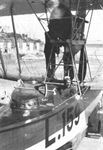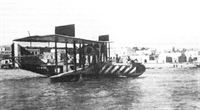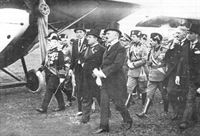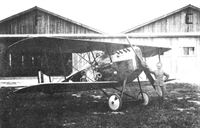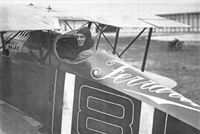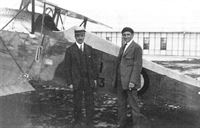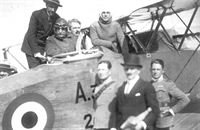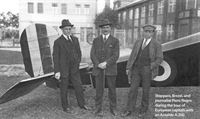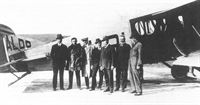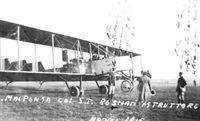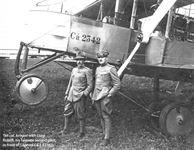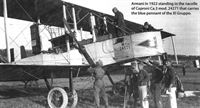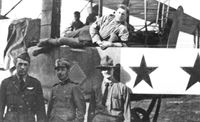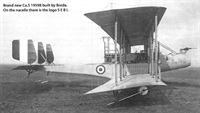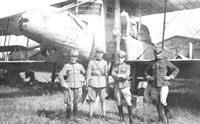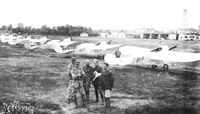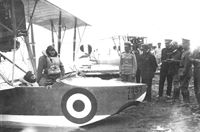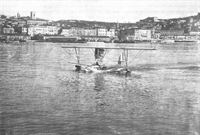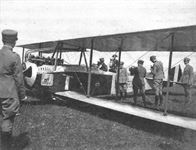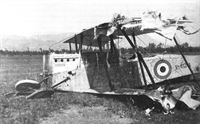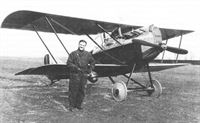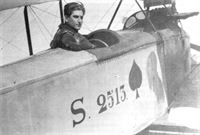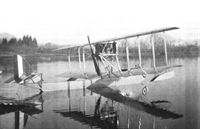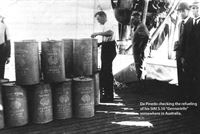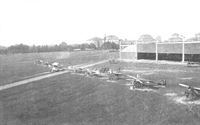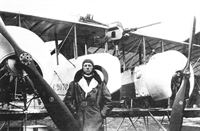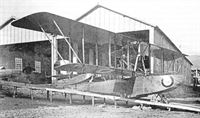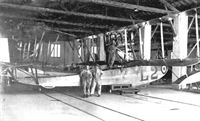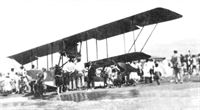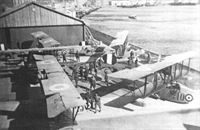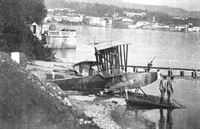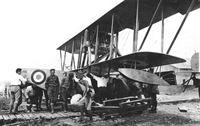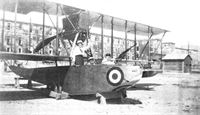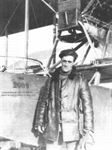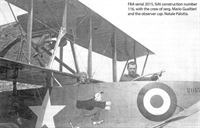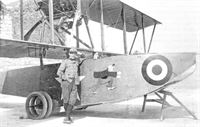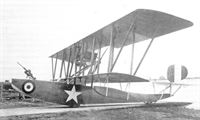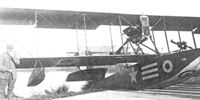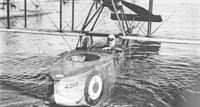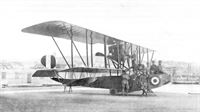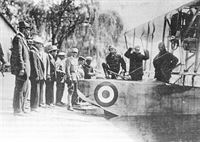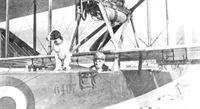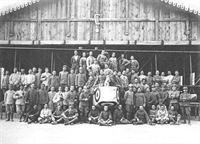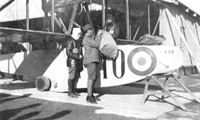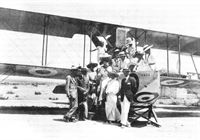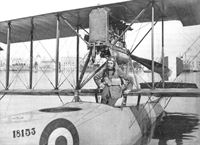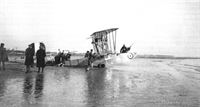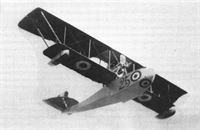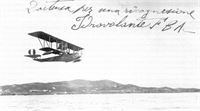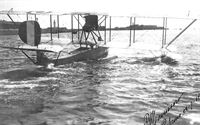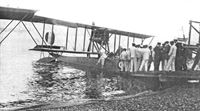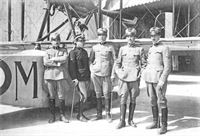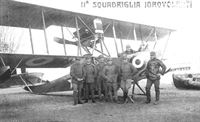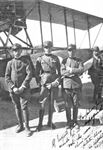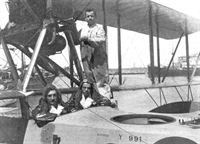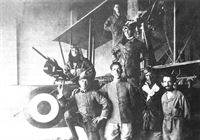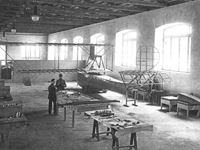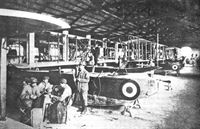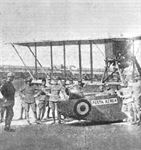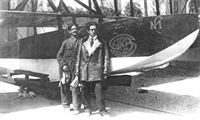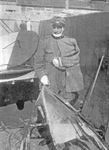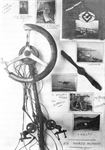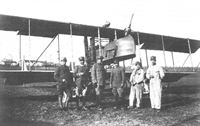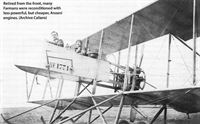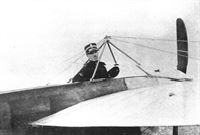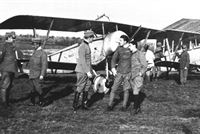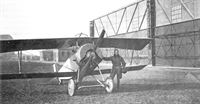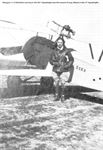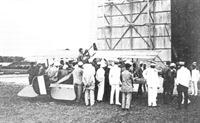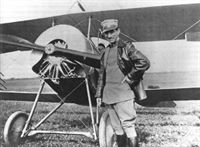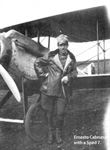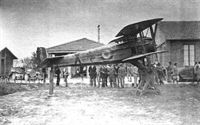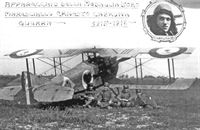Книги
Aeronaut
R.Gentilli
Italian Aviation Units in the First World War. Vol.5
262
R.Gentilli - Italian Aviation Units in the First World War. Vol.5 /Aeronaut/ (5)
Lohner L.1 159 serving as a trainer in Taranto. The pilot in the cockpit is the American Harold Kantner, later a designer and test pilot with Convair.
In front of a crash-landed Bristol Fighter of the RAF, three Italian aces: Ruffo di Calabria, De Bernardi, and Piccio.
Some of the airplanes of the 350a Squadriglia at El Palomar airfield, Argentina: two Aviatiks, a Fiat R.2, two Farmans, a Caproni Ca.5.
Brandenburg C.1 61.57, captured on 7 April 1916, was tested at Mirafiori. Behind it there is Caproni Ca.1 724 with experimental cowlings covering its engines. (Archive Schifano)
On 4 November 1923, authorities walk during the first parade of the newly born Regia Aeronautica. From the left: Admiral Thaon di Revel, Gen. De Bono, a fascist leader, Finzi, Mussolini, Arturo Mercanti, chief of civil aviation, behind them Italo Balbo. The airplane is a German Sablatnig P.3.
Natale Palli at San Pelagio with the specially decorated Ansaldo Balilla that he received as a gift from the Chamber of Commerce of Genoa. This airplane still exists, at the Caproni Museum in Trento.
Arturo Ferrarin in an Ansaldo Balilla ready to fly aerobatics at an air meeting in Nice, France, 1919.
A moving image, a photo, obviously for a young boy, reading "From heaven uncle Aldo today sends to Gino his wishes for much happiness. Rome, 25 June 1944." Finzi had been shot on 24 March.
Nicola Bo, on SVA 6822 of the 2a Sezione, after the war moved to South America, giving an important contribution of aviation in Paraguay.
The pilots who bombed Innsbruck. From the left, Arrigoni, Orsini, Palma di Cesnola, and Palli. This photo was distributed to the press, but with the roundel and the rooster censored.
Guido Masiero, the future flyer from Rome to Tokyo, with SVA 6839 of the 3a Sezione. This SVA crashed on 30 June 1918, killing ten. Vivarelli.
Unarmed SVA 6843 with pilot serg. Giovanni Trotti. The flag with the shield of the Visconti family, symbol of Milan, was clearly inspired from the flag of the 87a Squadriglia, with the Lion of St. Mark of Venice.
A SVA 6 of the 303a Squadriglia at Novi Ligure. The SVA 6 was a version without synchronizing gear, armed with a gun over the top wing.
Ansaldo SVA 4 #11728. The SVA series were strong, fast designs that served in numbers as long-range reconnaissance planes.
Ansaldo SVA 4 #11728. The SVA series were strong, fast designs that served in numbers as long-range reconnaissance planes.
SVA 5 11862, here carrying a 100-pound bomb, in 1919 ended up in Poland. In front of the windscreen there is a small skull, the size of an apple.
Antonio Locatelli completed the first aerial crossing of the Andes, from Argentina to Chile, with this SVA in 1919.
A SVA of the 4a Sezione showing the shield of the Visconti, the rulers of Milan in the Middle Ages. (Courtesy Claudio Caridi)
A SVA of the 4a Sezione showing the shield of the Visconti, the rulers of Milan in the Middle Ages. (Courtesy Claudio Caridi)
Marzari with SVA 11719. The black cat is adorned with his decorations: two wounds in action, three medals for valor, and the medal for "the hardships of war".
Mario De Bernardi at the Montecelio testing field in a SVA fitted with a hook to pick up messages from the ground.
This SVA was fitted with a hook to test for deck landing on an aircraft carrier, in 1923.
This SVA was fitted with a hook to test for deck landing on an aircraft carrier, in 1923.
The 272a Squadriglia received one Ansaldo ISVA, 16263, that was soon wrecked. The ISVA was a big failure; its performance was poor and no use for it was found. This is 15240 at Venice, where the plans to equip a fighter squadron with it were abandoned.
Marzari with SVA 9 13196 that he flew in the raid from Rome to Tokyo in 1920, managing to reach Turkiye.
SVA 10 #12847 of the 58a squadriglia with a shield, not a pennant. The insignia is the red halberd of Trieste.
The SVAs ready for departure in Rome, destination Tokyo. The one of Mecozzi was number 3, with serial 13200 and ten. Bilisco as passenger.
The pilots of the flight to Tokyo: from the left, Giuseppe Grassa, Umberto Re, Mario Gordesco, Ferruccio Ranza, Bruno Bilisco, Amedeo Mecozzi, Ferruccio Marzari and a civilian. None of them reached Japan, Grassa and Gordesco died.
Ferrarin and Masiero at Centocelle airport, ready to take off for Japan. Out of eleven airplanes that departed, only they arrived.
A SVA 10 of the Legionary Aviation, the small air force of the independent city of Fiume. On its fuselage a sword between two wings is painted.
An Italian SVA in Dalmatia, 1919, showing the shield with the halberd, insignia of the 58a Squadriglia.
Ferrarin in May 1923 flew the new prime minister of Italy, Mussolini, in an Ansaldo A.300 from Rome to Redipuglia, in the North-East, for a ceremony.
Stoppani, Brezzi, and journalist Piero Negro during the tour of European capitals with an Ansaldo A.300.
Stoppani, second from the left, in front of an Ansaldo A.300C, a passenger airplane with an enclosed cabin.
Aldo Bergonzi was a designer, he built at the Breda works in Milan a canard called Ardea, here shown at the aviation exhibition in Taliedo, August 1919.
A piece of fabric preserved in an Italian museum showing the color of Caproni bombers late in the war.
Brandenburg C.1 61.57, captured on 7 April 1916, was tested at Mirafiori. Behind it there is Caproni Ca.1 724 with experimental cowlings covering its engines. (Archive Schifano)
Caproni Ca.1 1165 at the Malpensa school. In the center is Silvio Resnati, who was killed in the crash of Caproni "Giulio Cesare" at Hazelhurst Field, New York, on 17 May 1918.
This Caproni Ca.3, serial 2330, used at Foggia, was called "the Russian", probably because it was the one ordered by Russia but never delivered.
Armani in 1922 standing in the nacelle of Caproni Ca.3 mod. 24271 that carries the blue pennant of the XI Gruppo.
Ca.5 Berlina 12036 of the Prima Squadra del Levante, first squad of the East, with the name Caproni written in Arabic characters and on its nose the Roman eagle, insignia of the Gruppo Comunicazioni Aeree. (Archive Mario Federighi)
Some of the airplanes of the 350a Squadriglia at El Palomar airfield, Argentina: two Aviatiks, a Fiat R.2, two Farmans, a Caproni Ca.5.
Some of the airplanes of the 350a Squadriglia at El Palomar airfield, Argentina: two Aviatiks, a Fiat R.2, two Farmans, a Caproni Ca.5.
Lordi's dog was chosen for the insignia of the 1a Squadriglia at Mirafiori, Turin. The Fiat BR.1 was a really big airplane.
The special contraptions used only for taxying were called "Checca", the Italian name for Maud the Mule, an American cartoon.
Gabardini monoplanes, nicknamed "Gabarda", the numbers 35, 45, and 50 indicate the horsepower of the engines.
In 1918 Gabardini introduced some conventional biplanes. The pupil in training is carabiniere Giovanni Zeppegno.
American and Italian officers, with at the center commander Calderara, at the Bolsena flying school, with an L.3 and an FBA.
Finzi introducing his wife to flying, in Aviatik I-ECIC of the CNA company at Centocelle, Rome. His marriage had been a big social event in Rome.
SAML S.2 3099 was serving as a trainer, while other SAMLs of the same production batch were fighting at the front.
A colorful SAML S.2 of the Italian Air Force. The SAML had an interesting history; it was an Italian version of the pre-war Aviatik B-type unarmed reconnaissance plane from Germany. Before the war Italy worked with the designer to arrange license production in Italy. The Aviatik two-seaters in Germany were largely removed from the front by the middle of 1917. However, the SAML, with more powerful engines and adequately armed, formed the backbone of Italian aviation units throughout the war. The sturdy SAMLs, although of modest performance, served reliably as newer Italian designs either suffered from prolonged teething problems or had to be grounded entirely.
Farman MFC 1980 at Terni: This unit was based close to a city, 250 miles from the front, so visits of civilians happened.
SP.2 3476 of the Sezione Difesa of Jesi. Formerly this airplane had served with the 31a Squadriglia.
Armed Farman MF 879 and an SP.2 of the Defense Flight in Foggia. Farman 879 then was sent to Libya. (USAF Museum)
This modified SP.4 was used for dropping secret agents with parachutes. In the center, with an overcoat, is Camillo De Carlo, the leader of the Giovane Italia organization.
SIAI S.8 serial 18279 of the 277a Squadriglia at Sapri. It doesn't carry attachment point for bombs nor other weapons.
The SIAI S.8 was another failure, it could not carry anti-submarine bombs and its flight characteristics were dangerous; the commander of the 272a Squadriglia crashed to his death in one of them.
Japanese Naval personnel examining the S.16 ter of De Pinedo. On its hull it shows the insignia of Point Cook naval air station, Australia.
Elwood Doherty was an American instructor at Taranto; in December 1915 he was offered a decoration for a daring exploration flight, which he refused, being the citizen of a neutral country. In 1914 he was pilot of the modified Langley Aerodrome that Glenn Curtiss prepared, trying to prove that the Wright brothers were not the first to fly.
Nine Bleriots and a Farman at the flying school of Venaria Reale, with the royal palace as background. (Archive Achille Vigna)
The Breguet at Mirafiori; behind it the airship hangar of that airfield. (Archive Lino Schifano)
Breguet BUC in Italian service at Mirafiori, Turin. (Roberto Gentilli)
Breguet BUC in Italian service at Mirafiori, Turin. (Roberto Gentilli)
About 50 of the excellent French Breguet 14 arrived in Italy; some were then sold to Turkiye, others went in the civil market.
A chart reporting the Italian record for altitude established by serg. Giovanni Vaglienti on 3 September 1916.
Like all units based in big cities, the 279a Squadriglia of Cagliari had lots of visitors when one of its seaplanes was on a beach.
A French-built FBA Type H at Desenzano, at that base the Scuola Alta Velocita, school of high speed, was established, where the pilots for the Schneider Trophy aces were trained.
FBA 445, c/n 141 of the Sezione of Naples. Life for aviators of the defense flights had some advantages compared to service in the Alps or in Albania.
FBA serial 2015, SIAI construction number 116, with the crew of serg. Mario Gualtieri and the observer cap. Natale Palotta.
Italian-built FBA 2017 with Hispano Suiza engine, showing the white star, insignia of the 2a Squadriglia Idro.
FBA 3157 was French-built, showing the white star and the horizontal bars of the 2a Squadriglia Idro.
An FBA marked T1 of the Sezione at Terranova Pausania in February 1918. The visible construction number, 269, indicates that its matricola (serial number) was 4261.
SIAI-built FBA serial 4262 of the 1a Squadriglia Idrovolanti, this aircraft was later assigned to the Sezione of Syracuse.
FBA 4283 with cap. De Bosis at the controls. On the hull there is the ribbon of the "Fatiche di guerra" medal, and on the roundel the shield of Savoy is painted. (Archive Paolo Monti)
FBA 5150 and 18999 of the 285a Squadriglia at Orbetello. Plans to turn this naval air station, from which Italo Balbo started in his historical mass flights across the Atlantic, into a historical site have not materialized yet.
The 268a Squadriglia at Rapallo mainly used FBAs built by the GIVES company in nearby Varazze, like the first in this line, 5224.
FBA 5616, c/n 329, was assigned to the 269a Squadriglia; here it is seen at the SIAI factory, on Lake Maggiore.
FBA 5634 was assigned to the 3a Squadriglia Idrovolanti. Here it is seen at the SIAI factory, fitted with a dummy machine gun. (Archive Caliaro)
The naval air station at Trapani, home of the 284a Squadriglia, was large and well equipped. In the forefront, FBA 6481 "T10" of the 284a Squadriglia. (Collection Paolo Monti)
Loading the mail for the Island of Lipari on FBA 6492 of the 280a Squadriglia. (Archive Scricciolo Monti)
For the 270a Squadriglia, being based in a big city away from the front, meant that visitors, particularly girls, were a frequent and appreciated occurrence. This is Mondello, the beautiful beach of Palermo.
FBA 18102, decorated with a skull, at the school of Bolsena. The instructor standing in the cockpit is 2° capo Pietro Valdimiro, a very capable veteran from the Stazione Miraglia of Venice.
On 28 June 1917 an FBA of Industrie Aviatorie Meridionali, with pilot Ruggero Franzoni, formerly a Caproni pilot at 2a Squadriglia, and mechanic Francesco Romanuzzi, completed an air mail flight from Naples to Palermo and back. (Archives Fiorenzo Longhi)
An FBA of the 273a Squadriglia in the port of Leghorn; the individual marking L6 is on a gray and white hull.
All the personnel of the 283a Squadriglia of Syracuse in front of an FBA. (Archive Scricciolo Monti)
An FBA of the 280a Squadriglia of Milazzo with officers from the 282a Squadriglia of Catania. (Archive Scricciolo Monti)
The airmen of the Brindisi Naval Air Station after a successful mission over Durazzo, 27 December 1917. Under the engine of the FBA, Orazio Pierozzi and Umberto Maddalena can be seen.
Three pilots of the 286a Squadriglia in Homs, Libya, July 1919. First from the left, Alessandro Passaleva, then the commander ten. Cappellotti. (Archive Longhi)
An FBA of the 271a Squadriglia at Civitavecchia, in front of the hull there is the model of a Nieuport fighter. The construction number, Y 991, indicates that the serial number is probably 7192.
An FBA of the 281a Squadriglia of Giardini Naxos, Sicily, with the commander cap. Pasquale Iodice. (Archive Scricciolo Monti)
American and Italian officers, with at the center commander Calderara, at the Bolsena flying school, with an L.3 and an FBA.
The 275a Squadriglia received mostly FBAs built by IAM, Industrie Aeronautiche Meridionali, in Naples. (Courtesy Ricci)
The provision of air mail services from the Italian mainland to Sardinia was widely reported in the press.
In the immediate postwar years Gennaro Pistone, like many other veteran pilots, tried to set up a private aviation company, that soon folded.
Roberto Lordi, first from the left, with other officers and Hanriot Hd.1 fighters of the 81a Squadriglia in a post-war photo.
On 12 July 1918 Scaroni on Hanriot HD.1 7157 was shot down and badly wounded, a victim possibly of Josef Vratil of Flik 14 or Franz Strasser of Flik 14/J.
Farmans of the Sezione Difesa Rimini. The first one, MF 827, formerly of the 29a Squadriglia, is armed with no less than ten Le Prieur rockets.
Armed Farman MF 879 and an SP.2 of the Defense Flight in Foggia. Farman 879 then was sent to Libya. (USAF Museum)
Farman Colomb 1719 of the Sezione Difesa of Ravenna. The pilot is ten. Enrico Cottino, who died on 16 May 1917. (Archive Caliaro)
Retired from the front, many Farmans were reconditioned with less powerful, but cheaper, Anzani engines. (Archive Caliaro)
Some of the airplanes of the 350a Squadriglia at El Palomar airfield, Argentina: two Aviatiks, a Fiat R.2, two Farmans, a Caproni Ca.5.
Nine Bleriots and a Farman at the flying school of Venaria Reale, with the royal palace as background. (Archive Achille Vigna)
A Nieuport 10, usually called "18 square meters" carefully restored and preserved at the Museo della Guerra of Rovereto.
Baracca, in the center, with Tacchini, left, and Scarpis, right, with Nieuport 11 1613 at Santa Caterina (Museo Baracca)
Before serving with the 301a Squadriglia in Foggia, Nieuport 11 1704 was the mount of serg. Gaetano Aliperta at the 82a Squadriglia. (USAF Museum)
Nieuport 11 2168 before serving in the 301a Squadriglia was the mount of serg. Allasia in the 77a Squadriglia.
Fucini, left, in front of his Nieuport 11 adorned with a lightning bolt, with serg. Emilio Zampieri of the Sezione Difesa Grottaglie.
Pilots of the 76a Squadriglia in 1916: from the left, Stoppani, unknown, Bonavoglia, unknown, unknown, Appiani, and Arrigoni.
Pier Ruggero Piccio with his Nieuport 11 equipped with Le Prieur rockets that he used to destroy an Austrian kite balloon.
Perfectly restored, Spad 7 S.2489 is now preserved in the Francesco Baracca Museum in Lugo di Romagna.
An original Spad 7 restored with the colors of Cabruna's plane is preserved in the Officers School of the Carabinieri in Rome. (Courtesy Marco Gueli)
In the spring of 1918 Cabruna had the shield of his hometown, Tortona, painted on his Spad. This airplane was exhibited at Genoa in 1919, then in Tortona, in Milan in 1934, and is now in the Italian Air Force Museum.
This post-war painting and a quote from a British journalist generated the now discredited theory that Baracca's prancing horse may have been red, not black.
A Voisin of the Sezione Difesa of Novi Ligure carrying flowers to be dropped to honor the victims of a railroad disaster, 5 August 1917.
Gino Allegri began his career at the Sezione Difesa of Cairo Montenotte; he died flying with the 87a Squadriglia "Serenissima" and was awarded the Gold Medal for Valor. The photo is signed "L'amico pipistrello" your friend the bat.


